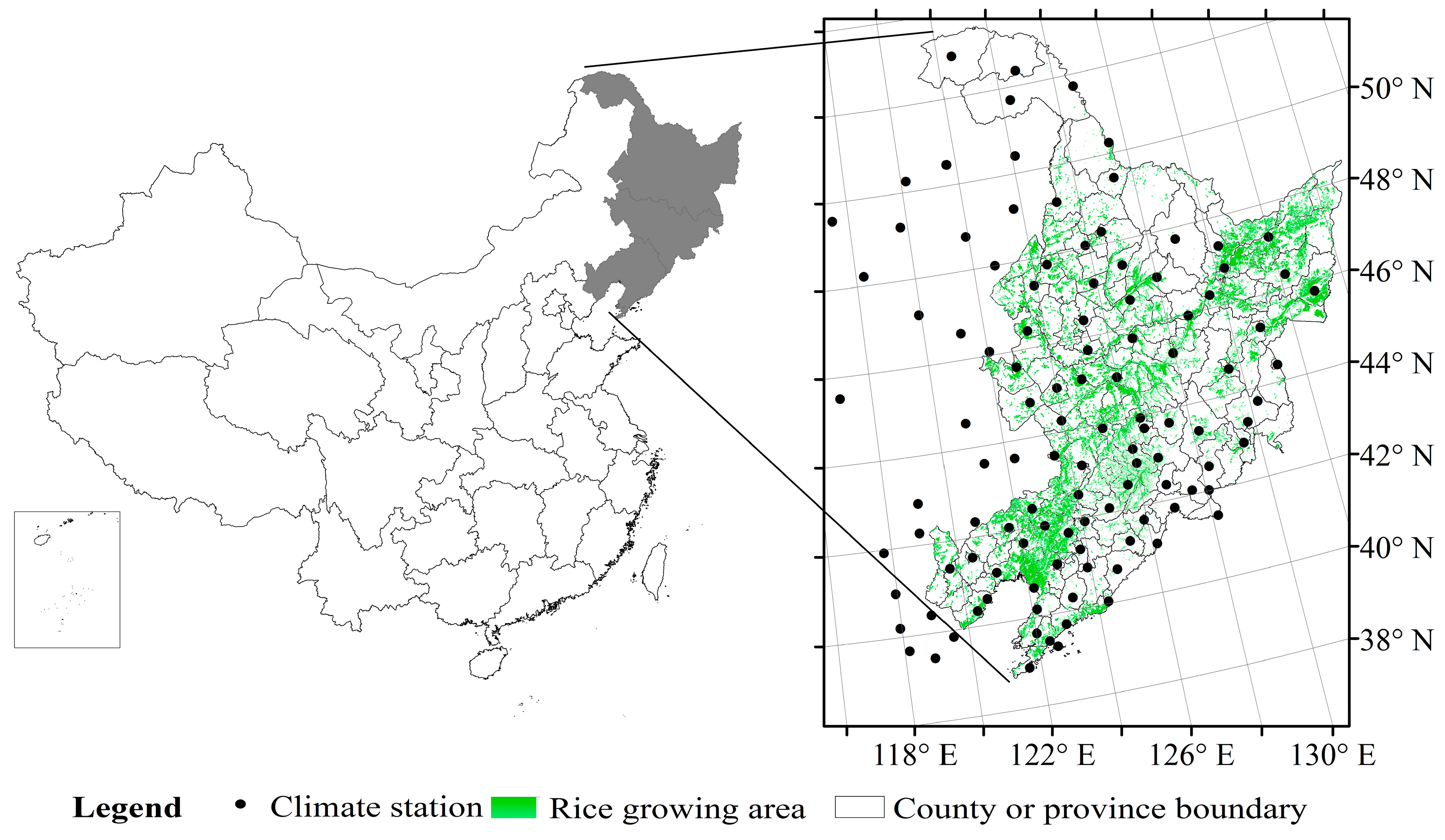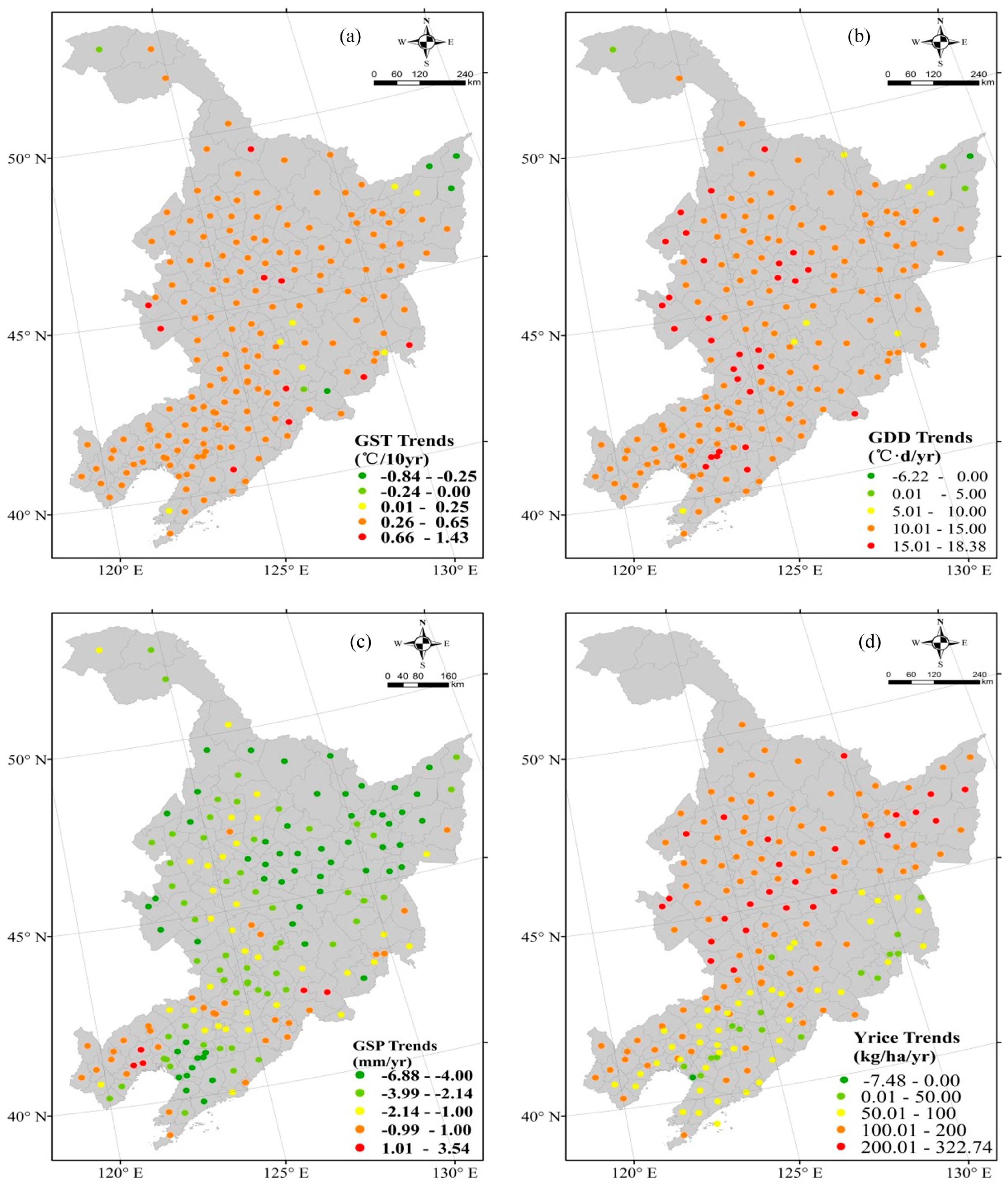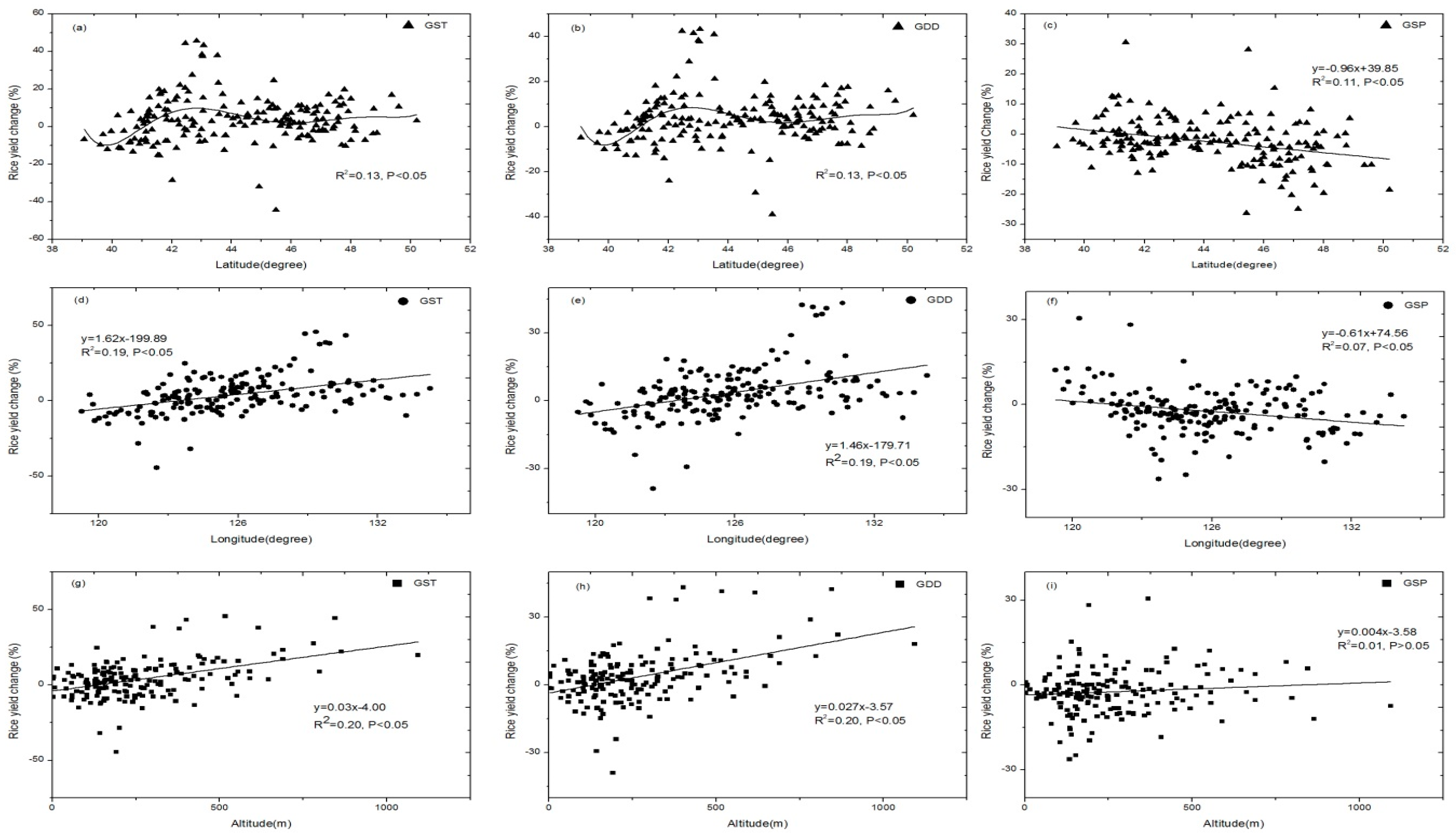Geographical Variation of Climate Change Impact on Rice Yield in the Rice-Cropping Areas of Northeast China during 1980–2008
Abstract
:1. Introduction
2. Data and Methods
2.1. Site Description
2.2. Rice Yield and Climate Data
2.3. Statistical Analysis
3. Results
3.1. Climate and Rice Yield Trends during 1980–2008
3.1.1. Climate Trends in the Rice-Growing Season
3.1.2. Rice Yield Trend
3.2. Climate-Rice Yield Relationship in the Northeast China (NEC)
3.3. Geographical Variation of the Climate-Rice Yield Relationship
4. Discussion
5. Conclusions
Acknowledgments
Author Contributions
Conflicts of Interest
References
- Lobell, D.B.; Schlenker, W.; Costa-Roberts, J. Climate trends and global crop production since 1980. Science 2011, 333, 616–620. [Google Scholar] [CrossRef] [PubMed]
- Tao, F.; Yokozawa, M.; Liu, J.; Zhang, Z. Climate-crop yield relationships at provincial scales in China and the impacts of recent climate trends. Clim. Res. 2008, 38, 83–94. [Google Scholar] [CrossRef]
- Xiong, W.; Holman, I.P.; Yang, J.; Li, Y.; Wu, W.; Yang, P. Impacts of observed growing-season warming trends since 1980 on crop yield in China. Reg. Environ. Chang. 2014, 14, 7–16. [Google Scholar] [CrossRef]
- Cruz, R.V.; Harasawa, H.; Lal, M.; Wu, S.; Anokhin, Y.; Punsalmaa, B.; Honda, Y.; Jafari, M.; Li, C.; Huu Ninh, N. Asia. Climate change 2007. In Impacts, Adaptation and Vulnerability. Contribution of Working Group II to the Fourth Assessment Report of the Intergovernmental Panel on Climate Change; Parry, M.L., Canziani, O.F., Palutikof, J.P., van der Linden, P.J., Hanson, C.E., Eds.; Cambridge University Press: Cambridge, UK, 2007; pp. 469–506. [Google Scholar]
- Shi, W.; Tao, F.; Zhang, Z. A review on statistical models for identifying climate contributions to crop yields. J. Geogr. Sci. 2013, 23, 567–576. [Google Scholar] [CrossRef]
- Hansen, J.W.; Challinor, A.; Ines, A.V.M.; Wheeler, T.; Moron, V. Translating climate forecasts into agricultural terms: Advances and challenges. Clim. Res. 2006, 33, 27–41. [Google Scholar] [CrossRef]
- Iizumi, T.; Yokozawa, M.; Nishimori, M. Parameter estimation and uncertainty analysis of a large-scale crop model for paddy rice: Application of a Bayesian approach. Agric. For. Meteorol. 2009, 149, 333–348. [Google Scholar] [CrossRef]
- Lobell, D.B.; Burke, M.B. On the use of statistical models to predict crop yield responses to climate change. Agric. For. Meteorol. 2010, 150, 1443–1452. [Google Scholar] [CrossRef]
- Nicholls, N. Increased Australian wheat yield due to recent climate trends. Nature 1997, 387, 484–485. [Google Scholar] [CrossRef]
- Lobell, D.B.; Asner, G.P. Climate and management contributions to recent trends in U.S. agricultural yields. Science 2003, 299, 1032. [Google Scholar] [CrossRef] [PubMed]
- Zhang, T.; Zhu, J.; Wassmann, R. Responses of rice yields to recent climate change in China: An empirical assessment based on long-term observations at different spatial scales (1981–2005). Agric. For. Meteorol. 2010, 150, 1128–1137. [Google Scholar] [CrossRef]
- Lobell, D.B.; Banziger, M.; Magorokosho, C.; Vivek, B. Nonlinear heat effects on African maize as evidenced by historical yield trials. Nat. Clim. Chang. 2011, 1, 42–45. [Google Scholar] [CrossRef]
- Schlenker, W.; Lobell, D.B. Robust negative impacts of climate change on African agriculture. Environ. Res. Lett. 2010, 5, 014010. [Google Scholar] [CrossRef]
- Peng, S.; Huang, J.; Sheehy, J.E.; Laza, R.C.; Visperas, R.M.; Zhong, X.; Centeno, G.S.; Khush, G.S.; Cassman, K.G. Rice yields decline with higher night temperature from global warming. Proc. Natl. Acad. Sci. USA 2004, 101, 9971–9975. [Google Scholar] [CrossRef] [PubMed]
- Welch, J.R. Rice yields in tropical/subtropical Asia exhibit large but opposing sensitivities to minimum and maximum temperatures. Proc. Natl. Acad. Sci. USA 2010, 107, 14562. [Google Scholar] [CrossRef] [PubMed]
- Gao, J.; Liu, Y. Climate warming and land use change in Heilongjiang Province, Northeast China. Appl. Geogr. 2011, 31, 476–482. [Google Scholar] [CrossRef]
- Chen, C.Q.; Qian, C.R.; Deng, A.X.; Zhang, W.J. Progressive and active adaptations of cropping system to climate change in Northeast China. Eur. J. Agron. 2012, 38, 94–103. [Google Scholar] [CrossRef]
- Ministry of Agriculture, PRC. The Statistics Database of Crops Sown Area and Production. 2012; Ministry of Agriculture, PRC. Available online: http://www.zzys.moa.gov.cn/ (accessed on 6 May 2013). (In Chinese) [Google Scholar]
- Ministry of Agriculture, PRC. New China Agricultural 60 Yearbook; Chinese Agriculture Press: Beijing, China, 2009. (In Chinese)
- Ministry of Agriculture, PRC. China Agriculture Statistical Report; Chinese Agriculture Press: Beijing, China, 2009. (In Chinese)
- Climatic Data Center, National Meteorological Information Center, China Meteorological Administration, PRC. The Data Set of Daily Ground Climate of China 1980–2010. 2012. Climatic Data Center. Available online: http://data.cma.cn/ (accessed on 15 June 2013). (In Chinese)
- Liu, J.; Zhang, Z.; Xu, X.; Kuang, W.; Zhou, W.; Zhang, S.; Li, R.; Yan, C.; Yu, D.; Wu, S.; et al. Spatial patterns and driving forces of land use change in China in the Early 21st Century. Acta Geogr. Sin. 2009, 64, 1411–1420. (In Chinese) [Google Scholar] [CrossRef]
- Wang, P.; Zhang, Z.; Song, X.; Chen, Y.; Wei, X.; Shi, P.; Tao, F. Temperature variations and rice yields in China: Historical contributions and future trends. Clim. Chang. 2014, 124, 777–789. [Google Scholar] [CrossRef]
- Yang, X.G.; Yu, H.N. Chinese Climatic Resources and Agriculture; Meteorological Press: Beijing, China, 2006. (In Chinese) [Google Scholar]
- Lobell, D.B.; Field, C.B. Global scale climate-crop yield relationships and the impacts of recent warming. Environ. Res. Lett. 2007, 2, 014002. [Google Scholar] [CrossRef]
- Zhang, T.; Huang, Y.; Yang, X. Climate warming over the past three decades has shortened rice growth duration in China and cultivar shifts have further accelerated the process for late rice. Glob. Chang. Biol. 2013, 19, 563–570. [Google Scholar] [CrossRef] [PubMed]
- Abdur Rashid Sarker, M.; Alam, K.; Gow, J. Exploring the relationship between climate change and rice yield in Bangladesh: An analysis of time series data. Agric. Syst. 2012, 112, 11–16. [Google Scholar] [CrossRef]
- Lobell, D.B. Changes in diurnal temperature range and national cereal yields. Agric. For. Meteorol. 2007, 145, 229–238. [Google Scholar] [CrossRef]
- Yao, F.; Xu, Y.; Lin, E.; Yokozawa, M.; Zhang, J. Assessing the impacts of climate change on rice yields in the main rice areas of China. Clim. Chang. 2007, 80, 395–409. [Google Scholar] [CrossRef]
- Lobell, D.B. Errors in climate datasets and their effects on statistical crop models. Agric. For. Meteorol. 2013, 170, 58–66. [Google Scholar] [CrossRef]
- Yao, F.; Qin, P.; Zhang, J.; Lin, E.; Boken, V. Uncertainties in assessing the effect of climate change on agriculture using model simulation and uncertainty processing methods. Chin. Sci. Bull. 2011, 56, 729–737. [Google Scholar] [CrossRef]
- Zhang, Z.; Song, X.; Tao, L.F.; Zhang, S.; Shi, W.J. Climate trends and crop production in China at county scale, 1980 to 2010. Theor. Appl. Climatol. 2016, 123, 291–302. [Google Scholar] [CrossRef]
- Lobell, D.B.; Burke, M.B. Why are agricultural impacts of climate change so uncertain? The importance of temperature relative to precipitation. Environ. Res. Lett. 2008, 3, 034007. [Google Scholar] [CrossRef]
- Lobell, D.B. Crop Responses to Climate: Time-Series Models. In Climate Change and Food Security: Adapting Agriculture to a Warmer World; Lobell, D., Burk, M., Eds.; Springer: Dordrecht, The Netherlands; Heidelberg, Germany; London, UK; New York, NY, USA, 2010. [Google Scholar]
- Tao, F.; Yokozawa, M.; Xu, Y.; Hayashi, Y.; Zhang, Z. Climate changes and trends in phenology and yields of field crops in China, 1981–2000. Agric. For. Meteorol. 2006, 138, 82–92. [Google Scholar] [CrossRef]
- Van Oort, P.A.J.; Zhang, T.; de Vries, M.E.; Heinemann, A.B.; Meinke, H. Correlation between temperature and phenology prediction error in rice (Oryza sativa L.). Agric. For. Meteorol. 2011, 151, 1545–1555. [Google Scholar] [CrossRef]
- Zhang, T.; Zhu, J.; Yang, X.; Zhang, X. Correlation changes between rice yields in North and Northwest China and ENSO from 1960 to 2004. Agric. For. Meteorol. 2008, 148, 1021–1033. [Google Scholar] [CrossRef]
- Yu, Y.; Huang, Y.; Zhang, W. Changes in rice yield in China since 1980 associated with cultivar improvement, climate and crop management. Field Crops Res. 2012, 136, 65–75. [Google Scholar] [CrossRef]
- Sun, W.; Huang, Y. Global warming over the period 1961–2008 did not increase high-temperature stress but did reduce low-temperature stress in irrigated rice across China. Agric. For. Meteorol. 2011, 151, 1193–1201. [Google Scholar] [CrossRef]
- Zhang, H.; Tao, F.L.; Xiao, D.P.; Shi, W.J.; Liu, F.S.; Zhang, S.; Liu, Y.J.; Wang, M.; Bai, H.Z. Contributions of climate, varieties, and agronomic management to rice yield change in the past three decades in China. Front. Earth Sci. 2016, 10, 315–327. [Google Scholar] [CrossRef]
- Li, Z.G.; Liu, Z.H.; Anderson, W.; Yang, P.; Wu, W.B.; Tang, H.J.; You, L.Z. Chinese Rice Production Area Adaptations to Climate Changes, 1949–2010. Environ. Sci. Technol. 2015, 49, 2032–2037. [Google Scholar] [CrossRef] [PubMed]
- Liu, Z.H.; Yang, P.; Tang, H.J.; Wu, W.B.; Zhang, L.; Yu, Q.Y.; Li, Z.G. Shifts in the extent and location of rice cropping areas match the climate change pattern in China during 1980–2010. Reg. Environ. Chang. 2015, 15, 919–929. [Google Scholar] [CrossRef]
- Amin, R.M.D.; Zhang, J.B.; Yang, M.M. Effects of climate change on the yield and cropping area of major food crops: A case of Bangladesh. Sustainability 2015, 7, 898–915. [Google Scholar] [CrossRef]
- Schlenker, W.; Roberts, M.J. Nonlinear temperature effects indicate severe damages to US crop yields under climate change. Proc. Natl. Acad. Sci. USA 2009, 106, 15594–15598. [Google Scholar] [CrossRef] [PubMed]




| Variable | n | Neg_All | Neg_Sig | Pos_All | Pos_Sig | Trendmin | Trendmax | Trendmean |
|---|---|---|---|---|---|---|---|---|
| Yrice | 178 | 1 | 0 | 177 | 158 | −7.48 | 322.74 | 134.4 |
| GST | 178 | 5 | 4 | 173 | 164 | −0.84 | 1.43 | 0.42 |
| GSP | 178 | 164 | 18 | 14 | 10 | −6.88 | 3.54 | −2.79 |
| GDD | 178 | 1 | 1 | 177 | 175 | −6.23 | 18.38 | 13.17 |
| Climate Variable | n | Neg_All | Neg_Sig | Pos_All | Pos_Sig | Trendmin | Trendmax | Trendmean |
|---|---|---|---|---|---|---|---|---|
| ΔGST | 178 | 63 | 3 | 115 | 19 | −3061.5 | 2453.8 | 206.63 |
| ΔGSP | 178 | 121 | 23 | 57 | 5 | −6.96 | 12.71 | −0.85 |
| ΔGDD | 178 | 64 | 6 | 114 | 34 | −17.52 | 14.57 | 1.18 |
© 2016 by the authors; licensee MDPI, Basel, Switzerland. This article is an open access article distributed under the terms and conditions of the Creative Commons Attribution (CC-BY) license (http://creativecommons.org/licenses/by/4.0/).
Share and Cite
Liu, Z.; Zhang, G.; Yang, P. Geographical Variation of Climate Change Impact on Rice Yield in the Rice-Cropping Areas of Northeast China during 1980–2008. Sustainability 2016, 8, 670. https://doi.org/10.3390/su8070670
Liu Z, Zhang G, Yang P. Geographical Variation of Climate Change Impact on Rice Yield in the Rice-Cropping Areas of Northeast China during 1980–2008. Sustainability. 2016; 8(7):670. https://doi.org/10.3390/su8070670
Chicago/Turabian StyleLiu, Zhenhuan, Guojie Zhang, and Peng Yang. 2016. "Geographical Variation of Climate Change Impact on Rice Yield in the Rice-Cropping Areas of Northeast China during 1980–2008" Sustainability 8, no. 7: 670. https://doi.org/10.3390/su8070670





